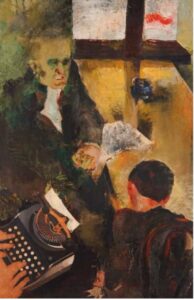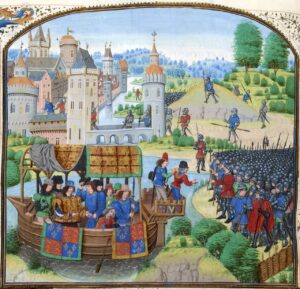“With Pen and Pistol” Event Highlights Heroines of the Holocaust
By Erin Letourneau
In partnership with the Holocaust Memorial Center, the Women’s and Gender Studies Program at Detroit Mercy hosted an event on March 15 with hopes of educating the audience on the many heroines who, to save themselves and others, fought with defiance and dignity during the Holocaust. The discussion was led by Dr. Lori Weintrob, Professor of History and Director of the Wagner College Holocaust Center in Staten Island, New York.
Weintrob opened the discussion by proposing questions imploring the audience to identify the role of women and resistance in Holocaust education. Being informed about these Heroines, she said, will lead to “deepening our understanding of the Holocaust as whole.”

Focus remained on a few of the many significant women, whom Weintrob referred to as “Rescuers & Resisters.”
One woman, Friedl Dicker-Brandeis, used her talent as an artist to educate people on the tragedies of the Holocaust. Some of her most famous works include “This is How the World is, My Child” from 1933 and “Interrogation” from 1934, which she painted while in captivity for participation in the antifascist movement.
Before being captured and killed by the Gestapo in 1944, Marianne Cohn, another significant woman of the Holocaust, smuggled 200 children in small groups into Switzerland or French farmlands. EIF or French Jewish Scouts assisted in her efforts and altogether rescued over 1800 young adults and children. Cohn was described as never faltering or relenting even through all the interrogation by the Gestapo.
Cohn and another resister, Vitka Kempner, belonged to Zionist Youth Groups. Kempner’s group specifically turned into a resistance group known as the “Avengers.” Led by Abba Kovner, this group became one of the most successful and famous all-Jewish partisan units during the War. Kempner was responsible for one of the first resistance acts of the group, creating and smuggling a bomb out of the ghetto to blow up a Nazi train line.
Another Jewish partisan fighter, Sara Gianaite-Rubinson, served in the resistance as a part of the “Death to the Occupiers” unit. She would return to the ghetto to save individuals and smuggle them out. Later in life she served as a professor lecturing on World War II history and social science at York University.
Finally discussed were the efforts of Zivia Lubetkin, the commander of the Warsaw Ghetto Uprising of 1943 at just 28 years old. She served a critical role in the uprising as a movement leader and resister.
Weintrob concluded her presentation and discussion by offering that the integration of “Holocaust Heroines” into history education can help us to further understand how the Holocaust happened. The stories of these women in particular can lead to dialogue and reflection. Their leadership and skills, with attention to strategies for human rights, need to be acknowledged and represented in Holocaust education.
“With Pen and Pistol” Event Highlights Heroines of the Holocaust Read More »

